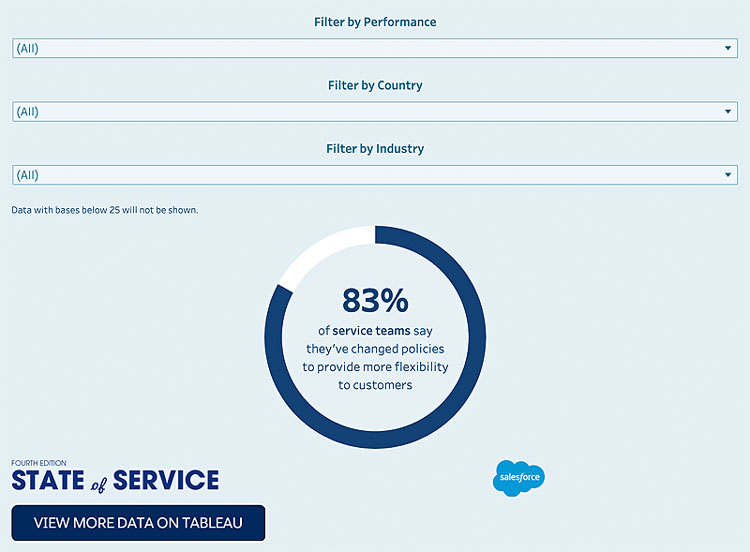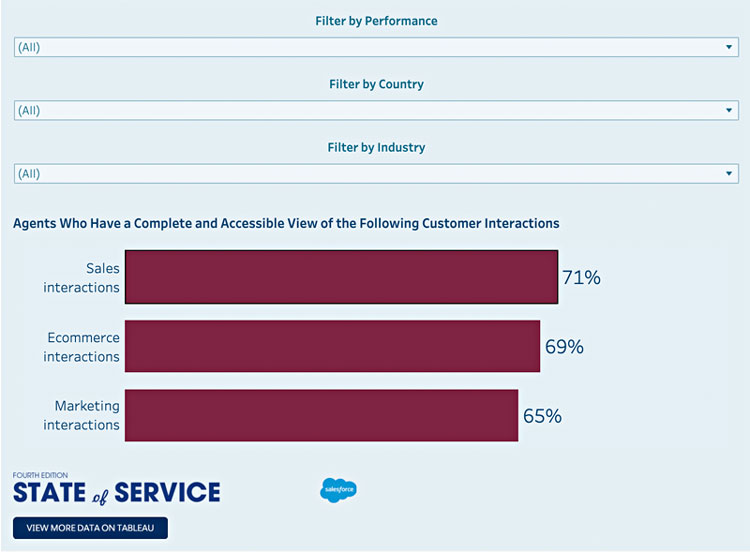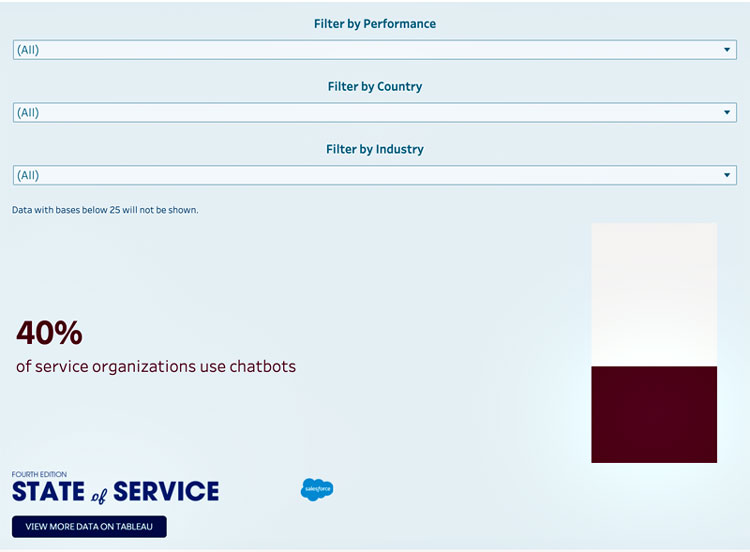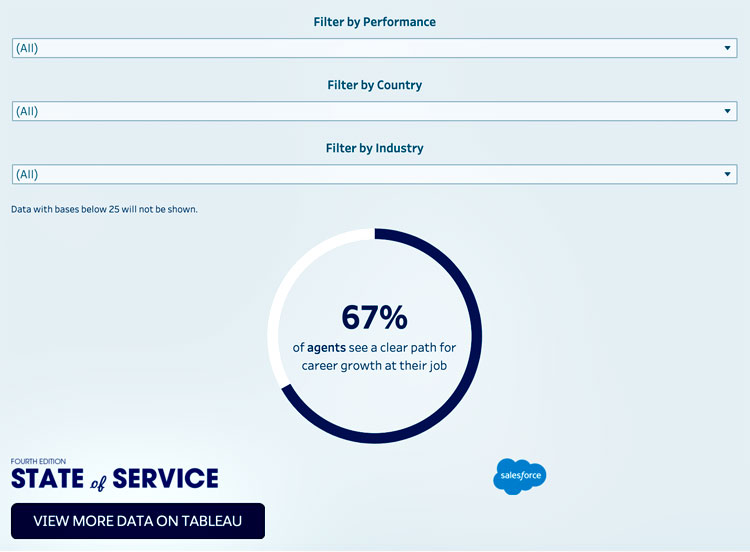Every business leader can agree the stakes have never been higher to build trust and maintain customer loyalty. Ninety percent of customers say how a company acts during a crisis demonstrates its trustworthiness.
Customer service has taken centre stage as companies build trust and drive loyalty today and into the future. Now, meeting customer service expectations while balancing distributed workforces and new business models means service professionals need to rewrite their approach to customer service. This includes key strategies to respond to customer needs, ways to help agents adapt to a more strategic role, and ensuring everyone stays safe.
We’ve compiled recommendations, based on insights from over 7,000 service professionals across 33 countries for the fourth edition of the State of Service report, to help write your next chapter on customer service. This article is long, so jump to any section:
- Chapter 1: Exceed expectations
- Chapter 2: Reduce silos
- Chapter 3: Adapt at scale
- Chapter 4: Support your team
Note: If you’d like to check out the State of Service findings first before diving in,
“I’ve used emotional intelligence to empathise with the client to provide the best solution. By doing so, I prevented the type of customer experience that leads to ‘cancel culture’ and instead put them on the path to customer loyalty”
Be empathetic:
Seventy-one percent of consumers say that businesses showing empathy during the pandemic have earned their loyalty. Teach emotional intelligence best practices. Conduct role playing exercises from the side of your customer and your organisation. Encourage agents to use positive language. Instead of saying, “That’s against our policy,” try, “Here’s how we can handle this.”
Turn agents into superheroes:
The right digital tools help agents use their time efficiently instead of searching for customer information or details from past interactions. Ensure agents have a 360-degree view on a complete service platform.
Let’s take a phone interaction as an example (customers choose phone calls second to email). Equipping agents with cloud telephony allows them to stay focused on the customer. That’s because calls are automatically transcribed in real time. At the same time, agents can access complete customer information for the context they need to deliver personalised service.
“Despite the challenges that COVID-19 has caused for business models, VIZIO continues to deliver service without disruption. We’ve focused on how to empower our agents and already had best practices and the right service management solution in place.”
Offer flexibility:
Eighty-three percent of service professionals say they’ve changed policies to provide more flexibility to customers during the pandemic. Agents on high-performing teams — those defined as having high customer satisfaction — are most likely to have clarity, encouragement, and training on how to be flexible with customers.
The key is to regularly communicate new updates. Train agents on new processes by setting up a customised digital learning module. And frequently audit your knowledge base to ensure articles are up to date.
“83% of service professionals say they’ve changed policies to provide more flexibility to customers during the pandemic.”
Chapter 2: Reduce silos
Sixty-seven percent of customers expect consistent interactions across departments. But 53% say it generally feels like sales, service, and marketing don’t share information.
Align your teams:
Everyone in your organisation affects the customer experience. Bring teams together to rally around the customer. Set shared goals. Encourage ongoing communication and collaboration. (Check out this Customer 360 playbook to help.)
Partner with IT:
Customer service has become more connected and more digital. This means partnerships with IT are critical. Eighty-eight percent of service decision makers call IT a strategic partner. Make technology strategy and selection a joint effort with IT.
“ Did you know that 88% of service decision makers call IT a strategic partner?”
Get a complete view:
Just under half (48%) of agents say they can find what they need on a single screen. To ensure they can deliver quality service, agents need access to service history, past interactions, and preferences. Platforms like Salesforce Customer 360 can help. It aggregates data into a single source of truth so everyone gets a complete view of your customers for the personalised support they expect.
Use your data:
Less than one-third (30%) of service decision makers say they have an excellent ability to use data to make strategic business decisions. That’s because it can be difficult to analyse data spread across systems. To combine data, try tools like MuleSoft. Mulesoft provides integration software for connecting data with application programming interfaces (APIs) to give a complete picture of how your service performs.
To help your teams do more with less, try these tips:
Scale support with chatbots:
Service organisations have increased adoption of chatbots by nearly two-thirds (67%) since 2018. Chatbots play an important role in answering common questions, like order status or password resets. If a case requires an agent, chatbots collect customer data and share it with the agent so that they have everything they need to resolve the case.
“Our customers increasingly want to engage with us online and by leveraging technology like bots there’s a significant opportunity for us to reduce phone calls and increase efficiency.”
Automate tasks:
Seventy-seven percent of agents say automating routine tasks, such as gathering basic information and customer feedback, allows them to focus on more complex work. Use automation to scale support, close cases faster, and classify cases, routing them to the next available agent with the right skillset. Automation also powers chatbots to collect information and resolve routine issues.
“77% of agents say automating routine tasks, such as gathering basic information and customer feedback, allows them to focus on more complex work.”
Predict actions:
Artificial intelligence (AI) analyses data and works behind the scenes to trigger actions. So, if a customer reaches out with a question on how to change a shipping address, AI can prompt next steps for the agent. (Learn more about how to apply AI to your customer service.)
Here’s what you can do to empower your team.
Invest in training:
In addition to their central role in keeping customers happy, the trend of service teams functioning as new and valuable sales channels puts them in increasingly high esteem. Use digital training tools like MyTrailhead to teach cross-sell and upsell techniques. On the flip side, train employees impacted by temporary store closures or layoffs to work in service and support. Sixty-two percent of service organisations say employees from other departments took on customer service roles during the pandemic.
“Service agents are optimistic about what the future holds. Sixty-seven percent see a clear career path — up from 59% in 2018.”
Commit to inclusivity:
Many brands have taken prominent stands to support inclusivity and accessibility. However, there’s still work to do. Four out of five of service professionals say they have formal policies in place to ensure accessibility for their customers and employees. Yet, few see truly accessible service and careers in practice. Help service be more accessible and provide resources that ensure people with disabilities have the tools they need to perform their jobs.
Encourage collaboration:
The majority of service professionals either expect to work remotely into 2021 or remain uncertain about their future work setting. Give your teams digital tools, like collaboration documents, to work together from anywhere in real time. Keep morale high by encouraging teams to connect on enterprise social networks or employee communities as well.
Offer visual remote assistance:
Seventy percent of consumers say they still prefer in-person service appointments over alternatives. Reduce the time onsite or eliminate the need for visits altogether to keep mobile workers safe with visual remote assistance. Transfer a customer to a mobile worker available by phone or video to walk them through step-by-step instructions. Or, have an experienced mobile worker remotely walk a local tech at the job site through how to resolve an issue.
Keep employees safe:
Eighty-two percent of customers say that treatment of employees during this year’s crises influence their decision to buy from a company. Try Work.com solutions, designed to help businesses adapt to the new ways of working. Assess employee health and wellness, train employees on new safety protocols, and manage shifts to reduce potential exposure to the virus.
“Concern over personal safety is first and foremost. We created a COVID-19 Pre-Arrival Checklist to build trust with our technicians and reassures them that we are committed to their health and safety as much as we are our customer.”
Get started:
Are you ready to write your next chapter? Get started by diving into the latest findings from the Salesforce State of Service report and join the conversation on social using the hashtag #StateofService.
To learn how you can build trust, earn and keep loyalty, and meet and exceed new customer service expectations quickly, discover Service Cloud.
This post originally appeared on the U.S. version of the Salesforce blog.







